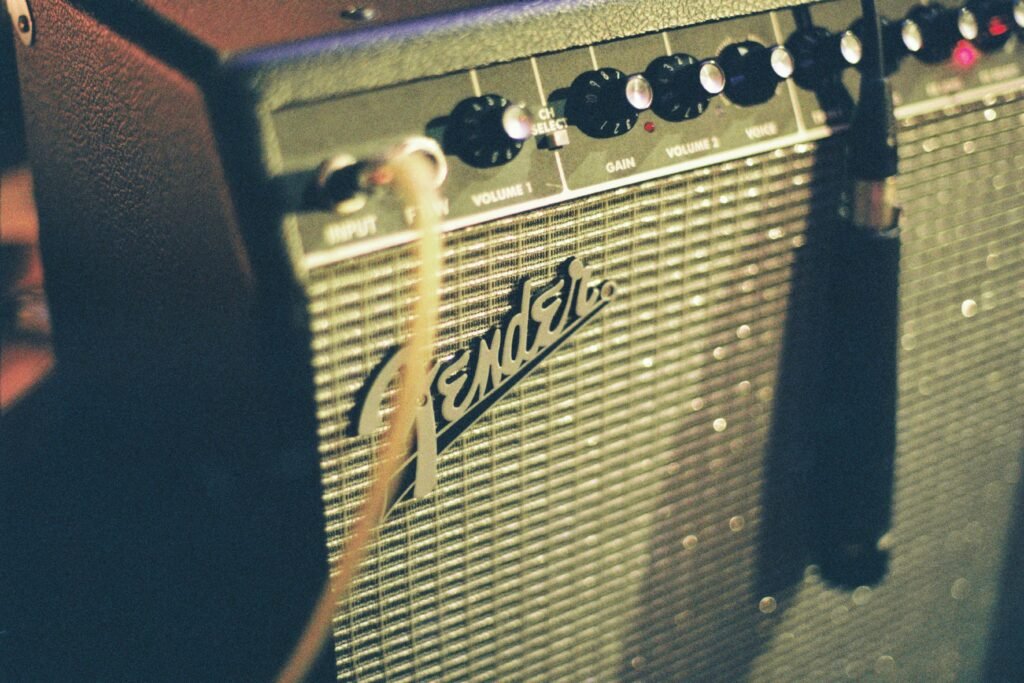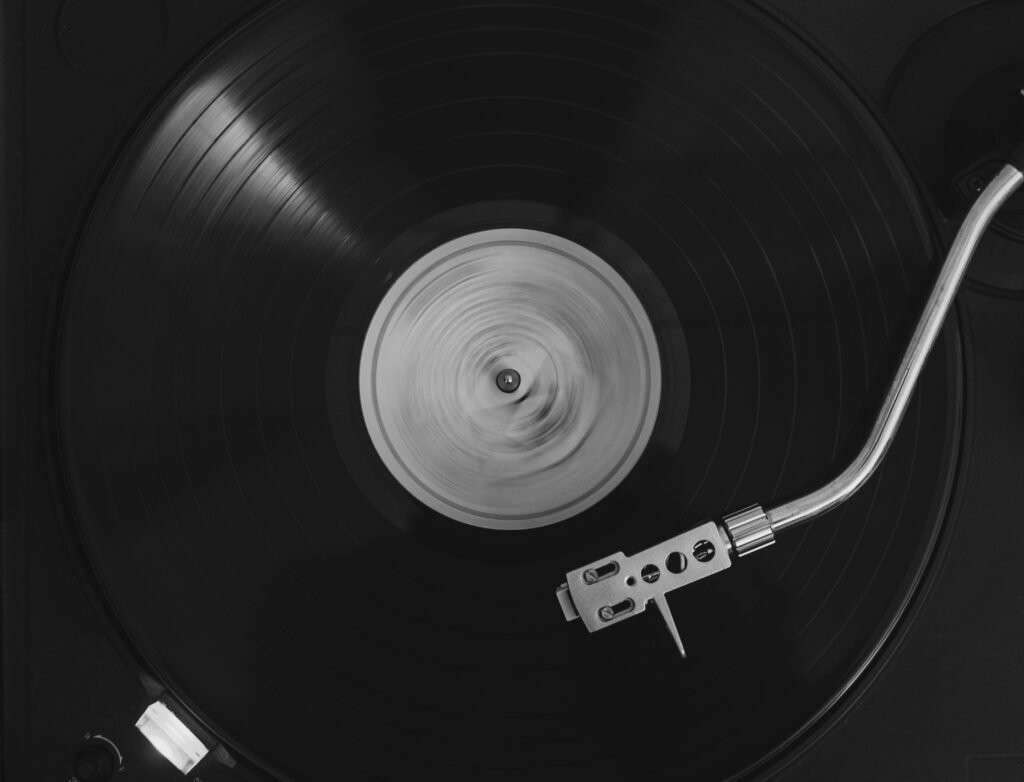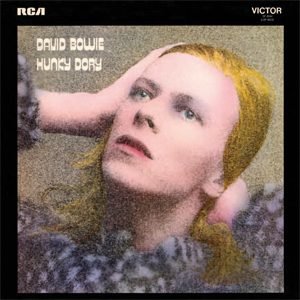Released in December 1971, Hunky Dory marks a pivotal point in David Bowie’s ever-evolving career. Coming off the raw energy and space-rock leanings of The Man Who Sold the World (1970), this album is both a departure and a deepening of Bowie’s artistry. Where its predecessor embraced a darker, heavier sound, Hunky Dory is a vibrant tapestry of eclecticism.
It blends whimsical folk-pop, glam rock, and introspective balladry, hinting at the grandeur of what was to come in Bowie’s career. This is Bowie exploring the full spectrum of his influences—from Bob Dylan’s lyricism to Andy Warhol’s pop-art ethos—while also nodding to the burgeoning glam rock movement that he would soon lead with The Rise and Fall of Ziggy Stardust and the Spiders from Mars.
Artistic Intentions
In the broader context of early 1970s music, Hunky Dory sits at a fascinating intersection. While many of his contemporaries were doubling down on the countercultural experimentation of the late ’60s, Bowie channeled his own eccentricities into a more accessible, yet still avant-garde, sound. His approach was not about fitting into one particular trend, but about synthesizing various musical styles into something uniquely his own. This blend of playfulness and emotional depth is what gives Hunky Dory its distinct identity, as it dances between breezy melodies and existential musings.
Bowie’s intentions with this album were as multifaceted as the music itself. In interviews, he spoke about wanting to create an album that expressed both his personal insecurities and his artistic ambitions. With Hunky Dory, Bowie isn’t just introducing us to a new sound; he’s introducing us to new facets of himself.
Whether he’s reflecting on the fragility of fame in “Changes” or paying homage to his heroes in tracks like “Song for Bob Dylan” and “Andy Warhol,” the album is as much about the people who shaped Bowie as it is about his own metamorphosis. In a sense, Hunky Dory is the blueprint for Bowie’s chameleon-like future, offering listeners an early glimpse of his restless creativity and endless hunger for reinvention.
Sonic Exploration

When it comes to production quality, Hunky Dory strikes a balance between polish and raw intimacy. Produced by Ken Scott, who had previously worked with The Beatles, the album has a clean, clear sound that allows the instrumentation to shine without being overproduced. Unlike the heavier, more guitar-driven tones of The Man Who Sold the World, Hunky Dory leans into a lighter, acoustic-based palette. The production is crisp yet organic, giving Bowie’s vocals space to breathe while highlighting the lush, textured arrangements. This clarity works hand-in-hand with the album’s themes of self-reflection and transformation, creating an inviting sonic atmosphere that lures the listener deeper into Bowie’s world.
Musical Arrangements
The musical arrangements on Hunky Dory are as eclectic as they are meticulously crafted. Rick Wakeman’s piano work is a standout feature across the album, especially on tracks like “Changes” and “Life on Mars?” His intricate, often classical-inspired playing adds a layer of sophistication that contrasts beautifully with the more straightforward guitar strumming.
Bowie’s vocals are also arranged with careful consideration, often shifting from an almost conversational delivery to grand, sweeping crescendos. On songs like “Quicksand,” for example, Bowie layers acoustic guitar with strings and piano, creating a delicate interplay between folk simplicity and orchestral grandeur. Meanwhile, in “Oh! You Pretty Things,” the jaunty piano lines and bouncy rhythm echo the cabaret style, offering a playful backdrop to the apocalyptic musings in the lyrics.
Genre Elements
In terms of genre, Hunky Dory is a masterclass in blending various musical influences into a cohesive whole. The album’s base leans towards folk-rock, but Bowie pushes far beyond those boundaries, incorporating elements of glam rock, pop, and art rock. The folk underpinnings are evident in the acoustic textures of songs like “Kooks” and “The Bewlay Brothers,” but there’s also a glam rock sheen starting to emerge, particularly in the theatricality of tracks like “Life on Mars?” The album’s genre-bending approach feels effortless, fusing the introspective lyricism of singer-songwriters with the bold, cinematic vision that would define Bowie’s later work.
Lyrical Analysis

David Bowie’s Hunky Dory is lyrically rich, weaving a tapestry of themes that range from personal transformation and identity to cultural commentary and existential musings. At its core, the album grapples with change—both personal and societal—presenting Bowie as an artist in transition, questioning his place in the world. The opening track, “Changes,” sets the tone, with Bowie reflecting on the inevitability of transformation: “Turn and face the strange” is a call not just to the listener but to himself, as he anticipates the shape-shifting career he would soon embark on.
This theme of self-reinvention, of embracing the unknown, permeates the album, echoing in songs like “Quicksand,” where Bowie meditates on the complexity of identity and belief, caught between nihilism and spiritual yearning.
Another recurring motif on Hunky Dory is Bowie’s exploration of fame, heroes, and the artistic process. On tracks like “Andy Warhol” and “Song for Bob Dylan,” Bowie pays homage to two artists who greatly influenced him, using them as mirrors to reflect on his own ambitions and insecurities. In “Andy Warhol,” he praises the pop artist’s detachment from fame, but in “Song for Bob Dylan,” there’s a more conflicted tone, as Bowie critiques Dylan’s mythologized persona while simultaneously acknowledging his influence.
These songs highlight Bowie’s fascination with the art of creation and the sometimes painful relationship between the artist and their public persona. Bowie, on the verge of his own breakthrough into superstardom, was beginning to grapple with these same tensions in his own life.
Lyrical Depth
Lyrically, Hunky Dory showcases Bowie’s talent for blending straightforward narrative with abstract, poetic musings. Some songs, like “Kooks,” offer a charmingly direct narrative. Written for his newborn son, Zowie, it’s a whimsical, almost conversational tune that reveals Bowie’s softer, more intimate side. In contrast, tracks like “Life on Mars?” are far more enigmatic. Described by Bowie as “a sensitive young girl’s reaction to the media,” the song is a surreal, kaleidoscopic journey through societal disillusionment, with cryptic imagery like “Mickey Mouse has grown up a cow” and “sailors fighting in the dance hall.”
The lyrics are filled with disjointed scenes that at first seem disconnected, but ultimately paint a vivid picture of a world unraveling under the weight of its own absurdity. This mix of narrative clarity and lyrical abstraction makes Hunky Dory a deeply layered work, open to multiple interpretations.
Emotional Impact
Emotionally, the album runs the gamut from lighthearted and playful to introspective and melancholic. Bowie’s ability to evoke empathy through his lyrics is particularly strong on tracks like “Quicksand” and “The Bewlay Brothers.” In the former, his confessional lyrics reveal a man struggling with doubt and existential fear, his voice tinged with vulnerability as he sings, “I’m sinking in the quicksand of my thought.” There’s a haunting quality to the song, as Bowie invites the listener into his internal turmoil. Similarly, “The Bewlay Brothers,” with its cryptic lyrics about siblings and fractured identities, evokes a deep sense of alienation and introspection.
On the other hand, songs like “Kooks” and “Oh! You Pretty Things” inject a dose of joy and whimsy, offering moments of lightness amidst the heavier themes. In “Kooks,” Bowie’s warmth and humor shine through, as he affectionately sings to his newborn son, promising to raise him in a world of “kooks” and outsiders, with an invitation to embrace the oddities of life. The emotional range of Hunky Dory is vast, oscillating between introspective contemplation, playful absurdity, and moments of genuine tenderness, giving the album its emotional resonance and depth.
Cohesion and Flow

One of the most impressive aspects of Hunky Dory is how seamlessly the tracks flow into one another, despite their stylistic and thematic diversity. The album doesn’t follow a strict narrative, but there is a clear emotional arc that ties the songs together, giving Hunky Dory a sense of journey—one that mirrors Bowie’s personal and artistic exploration. The opener, “Changes,” sets the stage for what’s to come, with its playful but introspective musings on transformation. From there, the album unfolds with a mixture of lighthearted charm and deeper philosophical reflections, creating a dynamic yet cohesive listening experience.
Track Progression
The track progression is artfully curated to keep the listener engaged. After the breezy, self-aware “Changes,” Bowie shifts gears into “Oh! You Pretty Things,” which brings a more upbeat, piano-driven rhythm but continues to delve into the theme of societal evolution and generational shifts. The transition between these two tracks feels natural, as both songs deal with change, albeit from different angles.
This thematic thread extends into “Eight Line Poem,” a more understated, reflective piece that serves as a bridge to the grandiosity of “Life on Mars?” The shift into the latter’s cinematic sweep feels organic, as though the quiet contemplation of the previous track builds up to the emotional crescendo of “Life on Mars?,” one of Bowie’s most dramatic and enigmatic compositions.
Throughout the album, Bowie’s ability to balance whimsical, lighthearted tracks like “Kooks” with more existential, weighty songs like “Quicksand” is a testament to his mastery of flow. While “Kooks” injects a dose of playful energy, with its jangly acoustic guitar and quirky lyrics about fatherhood, the transition into the introspective “Quicksand” feels like a natural shift into darker, more introspective territory. The emotional pacing of Hunky Dory is meticulously planned, allowing moments of levity to counterbalance the more serious, brooding tracks. Even though songs like “Kooks” and “Andy Warhol” offer lightness, they don’t feel out of place within the broader thematic framework of the album.
Thematic Consistency
Thematic consistency is one of Hunky Dory‘s greatest strengths. Despite the album’s exploration of various musical styles—folk, glam, pop, and even cabaret—there is a clear through-line in terms of both emotion and message. Bowie’s ruminations on identity, societal change, and the role of the artist create a unifying thread that holds the album together. Even when the musical mood shifts—such as from the upbeat, jaunty “Oh! You Pretty Things” to the melancholic, atmospheric “The Bewlay Brothers”—the underlying themes of alienation, transformation, and self-discovery remain intact, providing a sense of cohesion.
There are no jarring shifts on Hunky Dory—every transition feels intentional, like turning the pages of a carefully written novel. Even when Bowie experiments with different genres and moods, the album feels like a cohesive body of work rather than a collection of disparate songs. The closer, “The Bewlay Brothers,” is a perfect example of how Bowie maintains thematic and emotional consistency to the very end. The cryptic, haunting nature of the track serves as a fitting conclusion, bringing the album full circle in its exploration of personal and artistic identity. It leaves the listener in a reflective space, mirroring the introspective tone that runs throughout the album.
Standout Tracks and Moments
Several tracks on Hunky Dory stand out not only for their artistic merit but for their emotional depth and lasting influence in David Bowie’s discography. These songs showcase his songwriting prowess, his flair for experimentation, and his ability to evoke deep emotion through both words and music. While every track on the album contributes to its overall magic, there are a few that truly encapsulate Bowie’s genius.
1. “Life on Mars?”
Arguably the crown jewel of Hunky Dory, “Life on Mars?” is an audacious blend of surrealist lyrics and sweeping orchestral arrangements. The song stands out for its grandiosity and emotional heft, driven by Rick Wakeman’s majestic piano work and Mick Ronson’s lush string arrangements. Bowie’s vocal delivery is full of drama, moving from vulnerability to bombast with ease. The line “Is there life on Mars?” captures both a sense of disillusionment with society and a yearning for something greater, making it one of Bowie’s most poetic and enigmatic pieces. This track is a perfect example of Bowie’s ability to turn personal and cultural discontent into something transcendent, mixing cinematic scope with introspective lyricism.
2. “Changes”
As the album’s opening track, “Changes” immediately sets the tone for Hunky Dory with its playful, yet deeply reflective, mood. The song is a celebration of reinvention, with Bowie’s lyrics capturing both the excitement and uncertainty that comes with embracing change. Lines like “Turn and face the strange” have become iconic, not only representing the ethos of the album but also serving as a manifesto for Bowie’s career. Musically, the jaunty piano and stuttering rhythm bring a pop sensibility that contrasts with the more introspective lyrics, making “Changes” a standout for its ability to fuse catchy melody with deeper themes of self-discovery.
3. “Quicksand”
“Quicksand” is one of the album’s most introspective and emotionally charged tracks. The acoustic guitar lays a gentle foundation for Bowie’s haunting exploration of doubt, existentialism, and identity. Lyrically, the song is dense with references to mysticism, philosophy, and occult symbolism, reflecting Bowie’s inner turmoil and search for meaning. The vulnerability in his voice, especially when he sings “I’m sinking in the quicksand of my thought,” creates a palpable emotional impact. It’s a track that rewards repeated listens, each time revealing new layers of lyrical and musical complexity, and it stands out for its deep introspective tone and masterful lyricism.
4. “Oh! You Pretty Things”
A deceptively upbeat track, “Oh! You Pretty Things” blends catchy piano pop with existential musings about human evolution and societal collapse. The song stands out for its clever lyrical contrast—while its jaunty, sing-along melody suggests a lighthearted vibe, the lyrics are filled with foreboding about the future, as Bowie sings about “Homo sapiens” being obsolete. This juxtaposition between light and dark makes “Oh! You Pretty Things” one of the album’s most innovative and memorable moments, combining pop accessibility with deeper intellectual undercurrents.
5. “The Bewlay Brothers”
The album’s closing track, “The Bewlay Brothers,” is another standout for its enigmatic lyrics and haunting atmosphere. Bowie has referred to it as one of his most personal songs, though its meaning remains cryptic, dealing with themes of identity, memory, and fractured relationships. Musically, the track is sparse and eerie, with Bowie’s vocals delivering a sense of haunting nostalgia and distance. What makes “The Bewlay Brothers” so memorable is its ambiguity—it feels like a personal confession wrapped in surreal imagery, leaving the listener with more questions than answers. It’s a track that lingers long after the album ends, perfectly capturing Bowie’s ability to blend emotional depth with a sense of mystery.
Memorable Moments
Throughout Hunky Dory, there are countless small moments of brilliance that highlight Bowie’s talent and the album’s impact:
Rick Wakeman’s piano in “Life on Mars?”: The soaring, almost operatic piano work is the backbone of the song and elevates it into something grand and cinematic, setting the tone for Bowie’s later experimentation with dramatic arrangements.
The orchestral crescendo in “Quicksand”: As the song builds towards its climax, the strings swell in a way that mirrors the emotional intensity of Bowie’s lyrics, creating a visceral connection between the music and the existential dread of the song.
The breakdown in “Oh! You Pretty Things”: The sudden shift from jaunty piano to darker, more foreboding tones captures the song’s underlying tension. It’s a moment where the seemingly playful energy is undercut by something much more ominous.
The eerie outro of “The Bewlay Brothers”: The song’s final moments, where Bowie’s voice becomes distant and distorted, create a sense of haunting finality. It’s a chilling, surreal ending that feels both deeply personal and disconcertingly ambiguous.
Artistic Contribution and Innovation

In terms of its place within the broader music landscape of the early 1970s, Hunky Dory occupies a unique position at the crossroads of multiple genres, pushing the boundaries of what pop, rock, and folk could achieve. Released in December 1971, it arrived during a time when music was undergoing significant changes. The counterculture of the 1960s had begun to wane, and musicians were exploring new ways to address personal and societal shifts.
Bowie, always a step ahead of his contemporaries, crafted Hunky Dory as an album that both embraced and transcended the genre conventions of its time, paving the way for the rise of glam rock while also infusing it with introspective lyricism, art-rock experimentation, and a theatrical flair that was distinctly his own.
Place in Genre/Industry
Hunky Dory stands out as a prelude to the glam rock movement that would dominate the early ’70s, with artists like T. Rex, Lou Reed, and Bowie himself at the helm. However, where glam rock was often defined by its flamboyant, electric guitars and bold, androgynous personas, Hunky Dory takes a softer, more introspective approach. Bowie doesn’t fully step into his Ziggy Stardust alter-ego here, but rather offers a transitional work that blends folk-inspired acoustic arrangements with the emerging glam aesthetic. In this sense, Hunky Dory is innovative because it’s not a full-on glam rock album, but it hints at the theatricality and gender-fluidity that would soon become staples of the genre.
The album also holds a significant place in Bowie’s own discography, marking a shift from the heavier, more psychedelic sound of The Man Who Sold the World to something more melodic and lyrically introspective. It also foreshadows the artistic leap he would take with The Rise and Fall of Ziggy Stardust and the Spiders from Mars the following year. Bowie uses Hunky Dory to carve out his identity as a boundary-pushing artist, willing to experiment with both sound and image in ways that the mainstream music industry had yet to fully embrace. This album proved that Bowie wasn’t just another rock star but an artist with a unique vision, poised to redefine what rock music could be.
Innovation
Hunky Dory is a masterclass in genre fusion, which in itself was innovative at the time. Bowie draws from a wide array of influences, from the folk rock of Bob Dylan to the baroque pop of The Beatles, and even hints of cabaret and art rock. The way Bowie stitches these diverse sounds together without losing the album’s overall cohesion is a major innovation.
Each song feels distinct—whether it’s the whimsical, piano-driven “Kooks” or the orchestral sweep of “Life on Mars?”—yet they all contribute to a unified artistic vision. Bowie’s ability to take the familiar (folk, rock, and pop) and filter it through his own lens was groundbreaking, as he created something that felt fresh, yet rooted in tradition.
Lyrically, Hunky Dory is a departure from the straightforward narratives often found in rock music of the era. Bowie’s use of abstract, sometimes cryptic, language pushes the listener into new interpretive territory. In tracks like “Quicksand” and “The Bewlay Brothers,” Bowie blurs the line between reality and fantasy, inviting a sense of ambiguity and depth that was unusual for mainstream rock at the time. His lyrics are poetic and rich with allusions to philosophy, occultism, and art, adding intellectual weight to the album’s emotional core. This focus on thematic exploration rather than linear storytelling was a fresh take for pop and rock audiences, who were more accustomed to the direct narratives of singer-songwriters like Joni Mitchell or James Taylor.
Another key innovation lies in the album’s production, particularly in how it uses instrumentation to enhance its themes. Rick Wakeman’s piano work is central to this innovation, elevating songs like “Life on Mars?” and “Oh! You Pretty Things” to new heights of complexity and emotion. The album’s mix of acoustic and orchestral elements alongside more conventional rock instrumentation was relatively uncommon in the early ’70s, making Hunky Dory stand out for its sophisticated arrangements. The balance of intimate, stripped-down tracks like “Kooks” with more grandiose, cinematic moments like “Life on Mars?” creates a listening experience that feels both personal and epic, a duality that Bowie would continue to explore throughout his career.
Lastly, Hunky Dory is innovative in the way it handles identity. Bowie’s exploration of self-reinvention—whether in “Changes” or through the homage-paying tracks like “Andy Warhol” and “Song for Bob Dylan”—is a precursor to the fluid identities he would embrace in future works. While not as visually theatrical as Ziggy Stardust or The Thin White Duke, Hunky Dory is the groundwork for Bowie’s fascination with altering personas and questioning the very notion of identity. This theme would become central to glam rock and later developments in pop culture, where self-expression and the deconstruction of traditional roles would become more widespread.
Closing Thoughts

Hunky Dory stands as one of David Bowie’s most important and influential works, a timeless album that showcases his range as both a songwriter and a visionary. Its greatest strength lies in its ability to balance intimate, personal reflections with grand, almost cinematic musical arrangements. Tracks like “Life on Mars?” and “Quicksand” take listeners on emotional and intellectual journeys, offering moments of both existential depth and whimsical charm. Bowie’s lyrical exploration of identity, transformation, and societal shifts taps into universal themes while still feeling uniquely his own, drawing listeners into his deeply personal artistic world.
Musically, the album is a masterclass in genre-blending, effortlessly weaving together folk, pop, glam, and art rock without ever feeling disjointed. The clean, polished production enhances the diverse instrumentation, from Rick Wakeman’s stunning piano work to the rich string arrangements, giving each track its own distinct sonic landscape. Bowie’s versatility shines here, not only in his experimentation with different sounds but also in his chameleon-like ability to embody different voices and characters within the album.
While Hunky Dory doesn’t have the visual flamboyance of Ziggy Stardust or the futuristic polish of Station to Station, its subtlety is part of what makes it so impactful. It invites the listener to delve into its lyrical and musical complexities, rewarding repeated listens with new layers of meaning. If there is a minor flaw, it may lie in the fact that its eclectic nature can feel somewhat scattered at times; yet, this diversity is also what gives the album its charm, allowing Bowie to explore different aspects of his artistry.
As a pivotal moment in Bowie’s career, Hunky Dory is the blueprint for much of his future work. It bridges the gap between the darker rock of The Man Who Sold the World and the glittering, otherworldly glam of Ziggy Stardust. It is an album that not only showcases Bowie’s musical range but also sets the stage for his continuous evolution as an artist, solidifying his reputation as a cultural innovator and trendsetter.
Hunky Dory is more than just an album—it’s a declaration of artistic intent. It’s Bowie at his most introspective, daring, and multifaceted, setting the stage for the revolutionary work that would follow. For listeners, it offers both immediate melodic satisfaction and deeper intellectual and emotional engagement. Its influence can still be felt today, and it remains a touchstone for artists looking to blend pop accessibility with avant-garde experimentation.
Official Rating
The decision to give Hunky Dory a perfect 10 is a reflection of its enduring impact on both music and culture. It’s an album that not only captures a moment in Bowie’s career but also transcends it, offering a timeless exploration of identity, change, and artistic expression. Few albums can blend so many genres, emotions, and ideas while maintaining such a cohesive and compelling vision. Hunky Dory is one of Bowie’s finest achievements, a perfect example of how art can challenge boundaries and remain relevant across generations.
